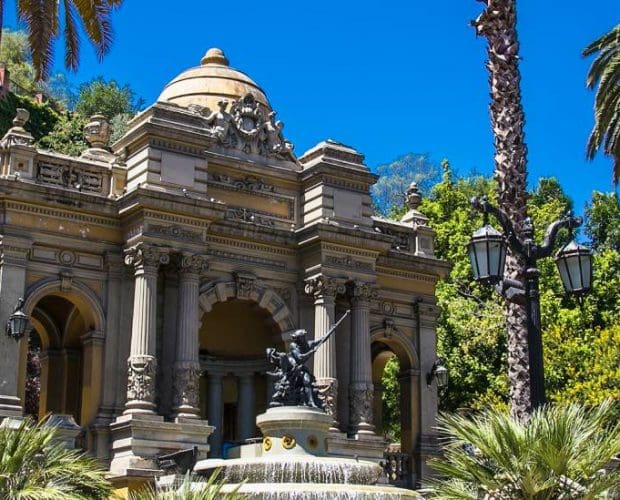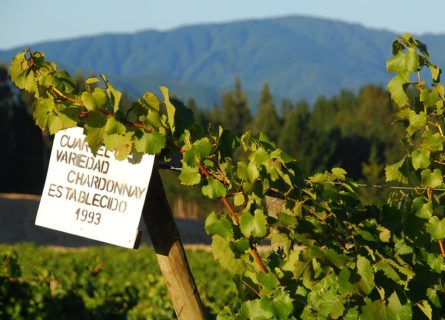Santiago: A dynamic blend of history, culture, and modernity, showcasing resilience and architectural marvels in Chile's cosmopolitan capital.
Read more
EXPLORE ALL OUR GUIDES TO CHILE'S WINE REGIONS
Last updated: June 20, 2025
The three leading players in Chile’s Zona Sur, Itata, Bío Bío, and Malleco, could hardly be more different from the sun-kissed vineyards of Maipo in the north. Bordered by the Pacific to the west and located over 400 kilometers from Santiago, this up-and-coming region is damp, verdant, and spectacularly beautiful. Yet the secret is already out: some of Chile’s most important producers have invested in Zona Sur (southern region), including Concha y Toro, Emiliana, and the Garage Wine Co. Today, cool-climate varietals are winning international awards, while passionate artisans are reviving old vine Moscatel and Pais. Riesling, Pinot Noir, Chardonnay, Viognier, and Sauvignon Blanc can all thrive here, often dry-farmed in these rich alluvial soils – a rare occurrence in hotter climes. The Zona Sur, once ignored by the wine elite, has become a phenomenal success story over the past 25 years.
And yet, this fertile valley is no stranger to the vine. Developed by Spanish Missionaries in the 1500s, European colonists planted the first Vitis vinifera: Pais and the ubiquitous Moscatel. By the 20th century, however, the vineyards of the south had been transformed into a factory, producing large volumes of low-grade wine. But, as the new generation prioritizes quality over a quick buck, its global reputation is being restored.
The southern regions of Itata, Bío Bío, and Malleco represent a very different side to Chilean viticulture. Located on the border with Maule, the vignoble runs for over 300 kilometers from north to south, encompassing 11,892 hectares of vines cultivated in forest-covered hills and majestic terrain.
According to Wines of Chile, “In total, while Itata is home to 8% of Chile’s vineyards, it has 44% of the country’s País and Moscatel vines. Like its neighbor to the north, the climate here is Mediterranean, but there is enough humidity in the air and rainfall to allow for dry farming.”
Indeed, the south is primarily defined by its proximity to the Pacific Ocean, accentuated by the greatly reduced influence of the Coastal Range. This famous mountain chain forms a sheltering sea wall in central Chile, protecting vineyards in Maipo and Rapel from the Humboldt current and moisture-filled marine air.
Yet, beginning at the city of Concepción, lower mountain elevation plays an important role in shaping the overall climate; a great deal more rainfall can travel inland in Zona Sur, reducing the need for irrigation. This is an enormous asset to local farmers, who rely on the weather’s natural rhythms to ripen their grapes without fear of water shortages – a growing issue in the north. However, the Itata and Ñuble rivers can provide emergency irrigation if needed.
With its maritime influences, intense sunlight, and fertile soils, the southern zone was traditionally a center of bulk wine production. This temptation remains today: growing conditions between the coast and the Andes make it ideal for farming of all sorts. But while bigger companies focus on high yields and supermarket plonk, they are increasingly outnumbered by quality-focused wineries.
Robert Echeverria Jr., chief winemaker at Viña Echeverria, now produces an exceptional Pinot Noir from the coastal-influenced terroirs of Malleco. At the same time, dry-farmed Carignan has caught the attention of the Garage Wine Co.
Robert Echeverria Jr. explains:
“Further south, we have been venturing towards the region of Itata with some of the highest concentrations of old vines in the Americas, typically dry-farmed. Here, people still ride around in horse and cart and trade vegetables in the market place – it’s like a trip back in time.”
Meanwhile, the town of Chillán, a center of wine production in Itata, translates as “the place where the sun is” in the pre-Columbian dialect of the Mapuche. For oenophiles accustomed to the highly developed infrastructure of the Central Valley, the vineyards of southern Chile are another world.
That applies to the region’s wild landscapes – forests, lakes, and mountain wildernesses – and magnificent wines. Ancient Moscatel bush vines, once despised, are now coveted by South America’s new wave of wine producers, as are newer plantations of Burgundy varietals, Riesling, and Viognier. Brisk acidity is a hallmark of this relatively cool climate, while free-draining clay-loam soils yield aromatic dry whites and structured, elegant reds. These superlative terroirs, rich in old vineyards, represent a new frontier of Chilean viticulture.

The revolution that has taken place in the Zona Sur has no parallel in living memory. Until (relatively) recently, the Itata and Bío Bío vineyards yielded unremarkable plonk that disappeared into anonymous blends and supermarket private labels: a reminder that Chile had low expectations of its vines and wines in the 20th century. Yet the region is now full of craftsmen, vinifying grapes taken from old bush vines and exploiting cooler climates to produce white and red Burgundy facsimiles. A credible rival to Leyda and Casablanca is slowly emerging in the far south.
At the same time, Zona Sur is an increasingly important hunting ground for Chile’s major exporters and international investors. Viña Aquitania was one of the first pioneers, earning critical acclaim for its best-selling Sol de Sol Chardonnay. Initially produced in collaboration with two Bordeaux winemakers – Bruno Prats and the late Paul Pontallier – the wine is truly outstanding. Low-yielding vines grown in the distinctly brisk Malleco Valley produce small berries of wonderfully concentrated fruit. These raw materials are then handled as gently and sensitively as possible: whole clusters are pressed to release very pure juice into the vat and fermented at low temperatures to bring out fruit and freshness.
After a small percentage undergoes malolactic fermentation, the wine is aged in oak for approximately nine months; however, only 10% of new wood is employed in the maturation stage. This fusion of volcanic terroir, nuanced winemaking, and sustainable viticulture is just one example of a spectacular revival in Chile’s southern regions, benefiting consumers worldwide.
Bío Bío
In many ways, Bío Bío is one of South America’s most important and dynamic producers despite lacking the impressive volumes of Curicó and Maule. Yet, while the acreage is relatively modest, it can boast exceptional growing conditions and mineral-rich soils. Indeed, the local climate could hardly be better for cool-climate varietals than in this beautiful subregion, located between the towering heights of the Andes and the Coastal Range to the south of Itata.
Slow ripening is the secret behind these unbelievably intense yet refreshing wines, a concomitant of the extended growing season in Bío Bío. A mixture of French and German white grape varieties set the standard here. However, Cabernet Sauvignon/Merlot blends provide a welcome counterpoint to the concentrated and powerful style made in the Central Valley.
Itata
Extending over 100 kilometers from north to south, Itata has become Chile’s premier cool-climate southern zone. First planted to vines in the 16th century, it is a story of revival, with a new generation of farmers treating ancient plantations of Moscatel and Pais with the respect they deserve. This excellent resource, Chilean vineyards producing wines with a unique flavor profile, was long underappreciated and lost in the hype that engulfs Maipo Cabernet and Casablanca Pinot Noir. This is slowly changing, however, thanks to the proselytizing of Derek Mossman Knapp and Miguel Torres Jr.
The cooling influence of the Itata and Ñuble rivers, combined with Pacific breezes, has encouraged investors to plant Burgundy varietals. However, old vine Cinsault and Carignan are the real scene-stealers.
Malleco
The story of Malleco is essentially the story of Miguel Torres Jr and Francisco Baettig – two of Chile’s greatest living winemakers. Having planted Chardonnay and Pinot Noir in some of the world’s southernmost vineyards, their enormous success has encouraged other investors to develop this nascent subregion, rich in clay and sandy terroirs.
Today, less than 90 hectares are planted in the zone, not least because the extremely cool climate and short growing season will only ripen certain grapes: Riesling and Pinot Noir are two such noble varieties. Yet Malleco Valley Sauvignon Blanc is also worthy of high praise, as is locally grown Viognier, endowed with the most intense apricot fruit imaginable. Wines produced here are quite different from the Chilean norm.
Chardonnay is a green-skinned grape varietal native to the Burgundy wine region in France and one of the most popular varieties worldwide.
Find out moreMuscat blanc is a white wine grape varietal popular in the Muscat d'Alsace, Moscato d'Asti and Beaumes-de-Venise regions.
Find out morePinot Gris is a white-wine grape variety originally from Burgundy. It is thought to be a mutant clone of Pinot Noir.
Find out moreThe sauvignon blanc grape varietal, originally from the Bordeaux region of France, is now one of the world's most loved white varieties.
Find out moreSauvignon Gris is a pink-berried mutation of Sauvignon Blanc, originally likely from Bordeaux but now also prominent in Chile. It is a relatively obscure grape, making up only 2% of Bordeaux's white wine grape production. Nearly extinct due to the phylloxera epidemic, its revival is credited to Jacky Preys, a winemaker from the Loire Valley.
Explore the allure of the Semillon grape & its legendary connection to Sauternes. Unveil the history & flavors of this captivating varietal. Cheers!
Find out moreDiscover Riesling's charm, a white grape from Germany's Rhine region, cherished in Alsace, France. Unveil its secrets and delights
Find out moreViognier comes from the northern Rhône valley AOC of Condrieu and is where its most famous white wines are produced.
Find out moreDiscover the irresistible allure of Cabernet Sauvignon—a worldwide favorite with robust, dark-bodied flavor. Unleash your wine journey today!
Find out moreCabernet Franc grape is a close relative of Merlot and Cabernet Sauvignon and is the principal blending grape used in Bordeaux.
Find out moreCarménère is a red wine grape from Bordeaux, France, once used for blending but is now mostly grown in Chile. Named for its crimson leaves in autumn, it's part of the Cabernet family and was one of Bordeaux's original six red grapes. Although rare in France today, Chile leads with the largest Carménère vineyards, exploring its blending potential, notably with Cabernet Sauvignon. The grape is also cultivated in Italy, Argentina, and parts of the United States.
Merlot is the most cultivated grape in Bordeaux and closely related to Cabernet Franc
Find out moreIn Argentina, the País grape, known as Criolla Chica, holds historical significance as one of the first Vitis vinifera varieties in the region. Though not as prominent as Malbec, it has been cultivated for centuries. Traditionally, Criolla Chica was used for bulk wine production, with high yields but low quality. Recently, interest in the grape has resurfaced, especially among natural winemakers who value its heritage. Despite this, it remains a niche variety, primarily used for rustic, traditional-style wines in Argentina.
Pinot noir is a light-bodied red wine varietal closely related to the Vitis vinifera grape and produces the most sought-after red wines in the world.
Find out moreSyrah is dark-skinned and perhaps the most underrated of the 'noble' red grape varieties.
Find out moreStunningly beautiful and completely unspoiled, Zona Sur is a pale shadow of Napa Valley in terms of cellar door experiences and luxury hotels. The city of Concepción, however, is no slouch in the gastronomy department, offering a broad selection of authentic restaurants and lively bars. Local seafood is a highlight: centola (king crab), merluza (hake), sea urchin, and gambas a la plancha shine alongside Bío Bío Chardonnay and fragrant Riesling grown in Malleco. Alternatively, savor fresh ceviche, mint-roasted lamb, steak, and rabbit in the untamed wilderness of the Zona Sur. If you want to escape other tourists, this is the place.
If you would like us to customize an exclusive luxury tour, contact us and let us know your travel plans. We offer luxury food and wine tours for private groups of a minimum two guests. In addition, all of our private, chauffeured tours are available year-round upon request.

